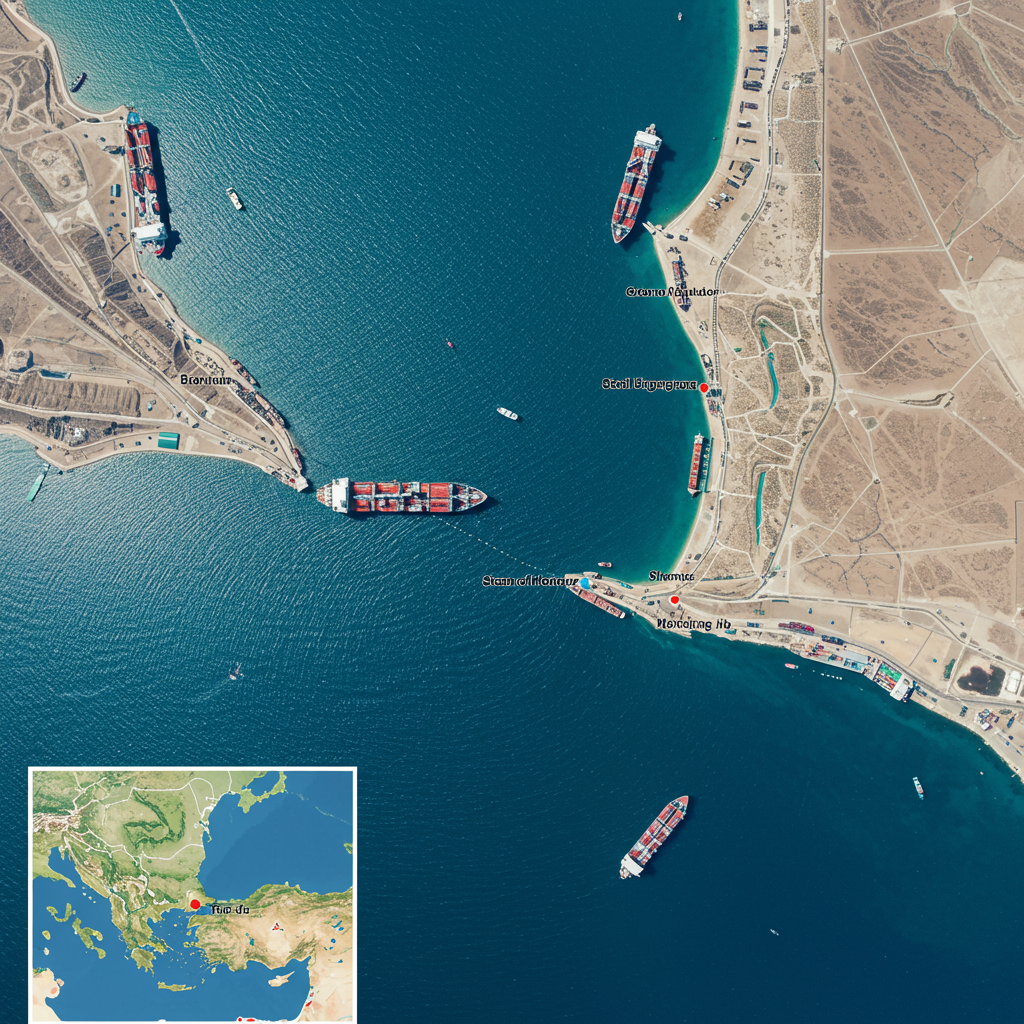Amid soaring tensions in the Middle East, fueled by unprecedented US strikes on Iranian nuclear sites and ongoing conflict between Israel and Iran, questions are once again being raised about Iran’s potential to disrupt global energy supplies by closing the Strait of Hormuz. This narrow, strategically vital waterway is indispensable to international maritime trade, acting as a critical chokepoint for a substantial portion of the world’s oil and gas shipments.
But could Iran really shut down this crucial passage? And what would be the global consequences if it did?
The Strait of Hormuz: A Global Energy Lifeline
Located between Oman and the United Arab Emirates on one side, and Iran on the other, the Strait of Hormuz connects the Persian Gulf to the Gulf of Oman and the wider Arabian Sea. At its narrowest point, the Strait is just 33 kilometers (21 miles) wide. The crucial shipping lanes, inbound and outbound, are confined to a mere 3 kilometers (about 2 miles) in width each, making the passage inherently vulnerable.
Its global significance is immense. Roughly one-fifth of the world’s total oil consumption – approximately 20 million barrels per day – transits through the Strait. This includes the vast majority of oil exports from major Gulf producers like Saudi Arabia, Iraq, Kuwait, Qatar, and the UAE, with most shipments heading towards vital markets in Asia. Beyond crude oil, large volumes of liquefied natural gas (LNG) and liquefied petroleum gas (LPG) also pass through this choke point daily. Protecting commercial shipping here is a key responsibility of the US Fifth Fleet, based nearby in Bahrain.
Why the Threat Re-Emerges Now
The latest surge in concern over the Strait of Hormuz is a direct consequence of the escalating regional conflict. Recent US military strikes, reportedly targeting three Iranian nuclear facilities, represent the first known direct American military action against Iran since the 1979 Islamic Revolution. Iran has vowed to respond to these strikes, which its Foreign Minister described as crossing “a very big red line.” Coupled with existing tensions stemming from the conflict between Israel and Iran, Tehran’s vows have dramatically heightened fears of a wider regional conflict and the potential for disruption to global maritime activity. Even before the latest strikes, escalating conflict had already contributed to a significant surge in ocean freight rates in the region.
How Iran Could Attempt to Disrupt the Strait
While a complete, physical barrier across the Strait isn’t practical for Iran, it could effectively halt traffic by making transit too dangerous for international shipping companies and their insurers. Potential methods include:
Mining the Shipping Lanes: Iran is believed to possess a significant inventory of mines and could attempt to lay them in the narrow shipping channels using various naval assets, including submarines and fast attack boats.
Missile Attacks: Employing anti-ship missiles from coastal batteries or naval vessels could target commercial ships or escorting military vessels.
Vessel Seizure and Harassment: Iran’s Islamic Revolutionary Guard Corps (IRGC) has a history of using its naval forces to intercept, seize, or harass tankers and other commercial vessels in the Gulf and Strait. Incidents date back to the “Tanker Wars” of the 1980s and have occurred as recently as 2023.
Iran’s naval capabilities, including a fleet of fast attack craft, drone carriers, and submarines, provide it with the means to undertake such disruptive actions. However, analysts note that shore-based assets would likely be quickly targeted by opposing forces.
Iran’s Internal Decision-Making
Within Iran, the authority to potentially close the Strait is not straightforward. While there have been reports of the Iranian parliament expressing support for the idea, the final decision-making power rests with the Supreme National Security Council, under the oversight of Supreme Leader Ayatollah Ali Khamenei. Reports suggest that a formal parliamentary bill to ratify the closure has not been finalized, indicating the decision is not yet absolute. Public comments from Iranian officials, including the Foreign Minister and Supreme Leader, have condemned adversaries and vowed retaliation but have largely avoided explicitly confirming plans to target the Strait.
Dire Global Economic Consequences
A sustained disruption or closure of the Strait of Hormuz would have severe and immediate global economic repercussions. Analysts warn that such a blockade could cause oil prices to spike dramatically, potentially pushing them well above $100 per barrel. This price shock would rapidly translate into higher fuel costs worldwide, fueling broader inflationary pressures that could impact everything from transportation to consumer goods. Oil-importing economies would likely face slower growth, potentially complicating the decisions of central banks regarding future interest rate cuts.
The economic fallout would be particularly acute for Gulf Arab states whose prosperity is tied directly to their energy exports through the Strait. It could also risk drawing them more deeply into the regional conflict to protect their vital economic interests. Asian economies, heavily reliant on Gulf oil imports via the Strait, would be significantly impacted. China, Iran’s largest oil customer (despite international sanctions), would face immense economic costs and supply chain disruptions, leading US officials to urge Beijing to pressure Tehran against any closure.
Why a Full Closure is Considered Unlikely
Despite the potential for disruption and the severe consequences, a full, sustained closure of the Strait of Hormuz is widely considered improbable due to several powerful deterrents:
Overwhelming US Military Response: The United States maintains a robust military presence in the region with a clear mandate to ensure freedom of navigation through the Strait. Any attempt at a full blockade would almost certainly trigger an immediate and decisive military response from the US and its allies aimed at rapidly reopening the waterway. Iran’s conventional military forces would be heavily outmatched.
Economic Self-Harm for Iran: Closing the Strait would halt Iran’s own crucial oil and gas exports, which are the backbone of its economy, particularly its significant sales to China. Such a move would be an act of profound economic self-destruction for the regime.
Pressure from Key Partners: China, the world’s largest importer of hydrocarbons and the main buyer of Iranian oil, is also heavily reliant on the Strait for imports from all regional producers. Beijing has a strong economic incentive to ensure the Strait remains open and is likely to exert significant pressure on Iran to avoid a full blockade.
- Alternative Export Routes: While not sufficient to fully replace the Strait, Saudi Arabia and the UAE have developed limited pipeline infrastructure that can bypass the waterway and export oil directly to the Red Sea or the Gulf of Oman, providing some degree of resilience for their exports.
- www.aljazeera.com
- www.forbes.com
- www.newsweek.com
- www.theguardian.com
- www.bbc.com
Beyond a Full Blockade: The Threat of Disruption
While a full, sustained blockade appears unlikely given the severe costs and international reaction it would provoke, analysts do not rule out the possibility of less drastic, localized disruptions. These could include temporary harassment of shipping, targeted seizures of specific vessels, or minor skirmishes – actions that fall short of a full closure but still create volatility and pose risks to maritime security and global energy markets. Historically, even severe disruptions to global oil supply have often seen price spikes reverse relatively quickly due to factors like spare production capacity and demand response to high prices.
In conclusion, while Iran possesses the capability to cause significant disruption in the Strait of Hormuz, a complete and sustained closure remains highly improbable. The act would invite overwhelming international military response, constitute economic “suicide” for Iran itself, and alienate key partners like China. Nevertheless, the Strait remains a volatile flashpoint, and in the current climate of heightened regional tensions, the risk of some level of maritime disruption, short of a full blockade, persists.



